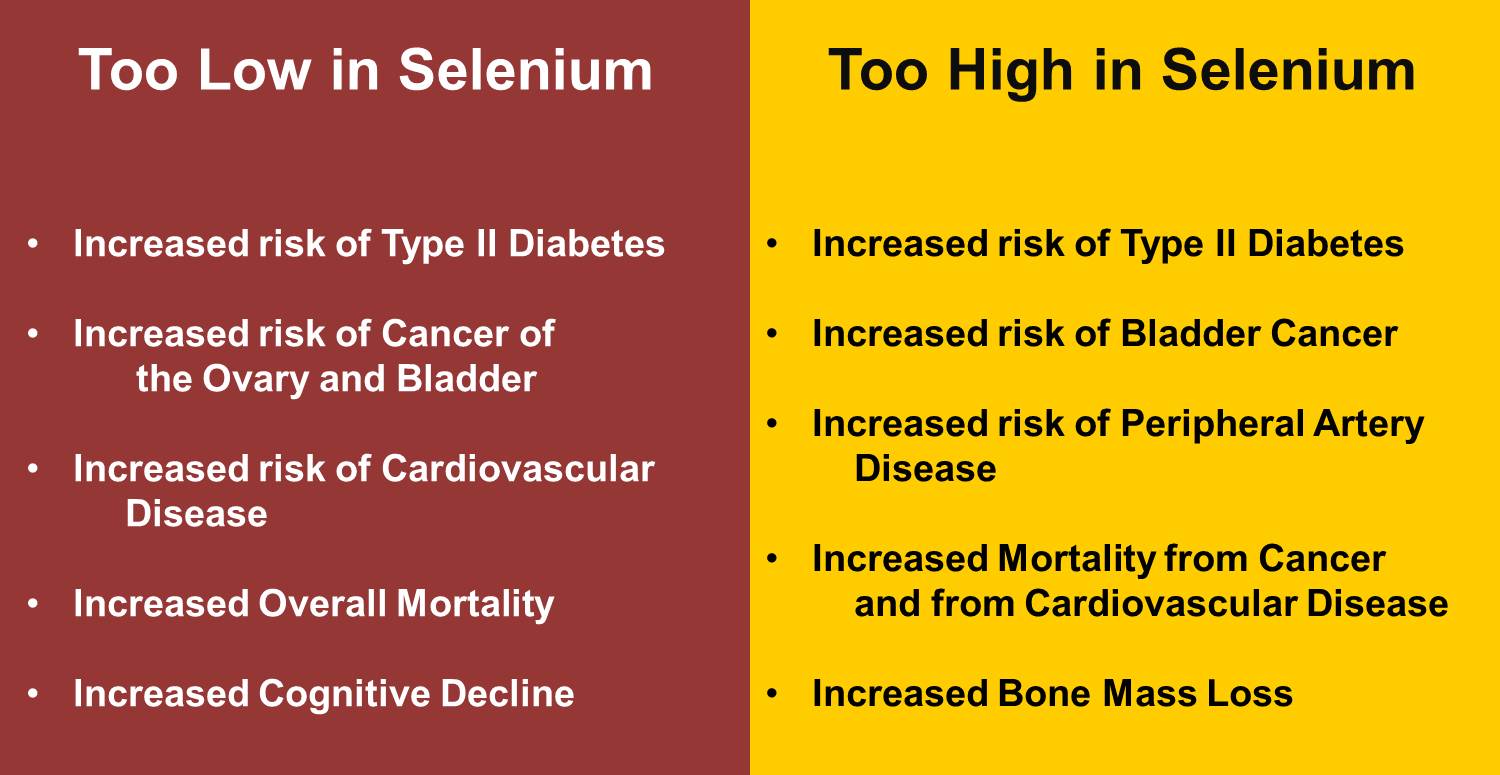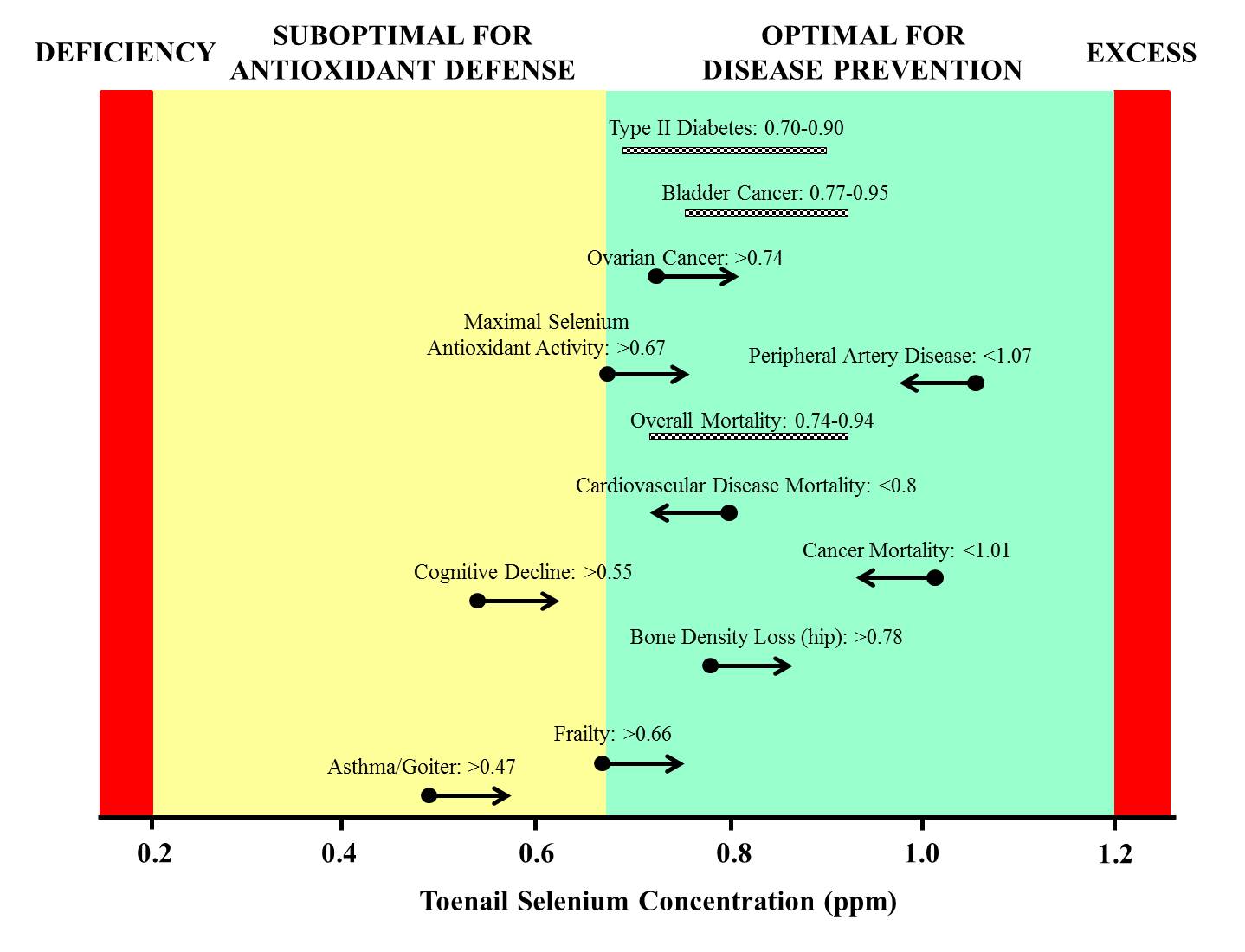Selenium and Women's Health
How selenium impacts disease risk and wellness in women

When it comes to your health, it pays to get your selenium level right. More of a good thing is not always better. And now a growing body of scientific evidence is supporting this U-shaped thinking – you want your selenium levels in mid-range status … not too low, not too high.
More of a Good Thing is Not Always Better: Learn More from a Synopsis of Scientific Reports Linking Selenium, Women’s Health, and U-shaped Thinking

Type II Diabetes
Park K, Rimm EB, Siscovick DS, Spiegelman D, Manson JE, et al. Toenail selenium and incidence of type 2 diabetes in U.S. men and women. Diabetes Care 2012;35:1544-1551.
Women with lower selenium status (0.6 ppm Se in toenail) had a 30% higher risk of type II diabetes then women with higher selenium status (0.75-0.90 ppm Se in toenail).
Laclaustra M, Navas-Acien A, Stranges S, Ordovas JM, Guallar E. Serum selenium concentrations and diabetes in U.S. adults: National Health and Nutrition Examination Survey (NHANES) 2003-2004. Environment Health Perspectives 2009;117:1409-1413.
Women with higher selenium status (equivalent to 1.01 ppm Se in toenail) were 6 times more likely to develop diabetes than women with lower selenium status (equivalent to 0.82 ppm Se in toenail).
Cancer
Wallace K, Kelsey KT, Schned A, Morris JS, Andrew AS, et al. Selenium and risk of bladder cancer: A population-based case-control study. Cancer Prevention Research 2009;2:70-73.
This study showed that the optimal selenium status for U.S. women to be protected from bladder cancer is mid-range status, 0.77-0.95 ppm Se in toenail. A significant 50% risk reduction was seen in women with mid-range selenium status compared to women with lower selenium status.
Helzlsouer KJ, Alberg AJ, Norkus EP, Morris JS, Hoffman SC, et al. Prospective study of serum micronutrients and ovarian cancer. Journal of National Cancer Institute 1996;88:32-37.
In this study, low selenium status (equivalent to less than 0.74 ppm Se in toenail) together with high cholesterol doubled ovarian cancer risk.
Gifkins D, Olson SH, Paddock L, King M, Demissie K, et al. Total and individual antioxidant intake and risk of epithelial ovarian cancer. BMC Cancer 2012;12:211-220.
This study conducted in New Jersey reported that ovarian cancer risk was significantly less in women who had higher selenium intake (59.5 ug Se intake/day) from food. Interestingly, selenium intake in the form of supplements did not provide the same protection.
Cardiovascular Disease
Bleys J, Navas-Acien A, Laclaustra M, Pastor-Barriuso R, Menke A, et al. Serum selenium and peripheral arterial disease: Results from the National Health and Nutrition Examination Survery, 2003-2004. American Journal of Epidemiology 2009;169:996-1003.
In this study, higher selenium status was associated with a lower incidence of peripheral arterial disease. However, selenium status that was too high (equivalent to >1.07 ppm Se in toenail) was associated with increasing incidence of disease.
Cominetti C, de Bortoli MC, Garrido AB Jr, Cozzolino SM. Brazilian nut consumption improves selenium status and glutathione peroxidase activity and reduces atherogenic risk in obese women. Nutrition Research 2012;32:403-407.
By eating Brazil nuts, obese women increased their selenium status (from an equivalent of 0.37 ppm Se to 0.89 ppm Se in toenail) and increased their circulating levels of good cholesterol (HDL-cholesterol).
Overall Mortality
Walston J, Xue Q, Semba RD, Ferrucci L, Cappola AR, et al. Serum antioxidants, inflammation, and total mortality in older women. American Journal of Epidemiology 2006;163:18-26.
Women with lower selenium status (equivalent to < 0.74ppm Se in toenail) were 1.5 times more likely to die
in the next 5 years than women with mid-range selenium status equivalent to 0.82-0.94ppm Se in toenail.
Bleys J., Navas-Acien A., Guallar E. Serum selenium levels and all-cause, cancer and cardiovascular mortality
among US adults. Archives of Internal Medicine 2008;168:404-410. This study concluded that too much selenium increases mortality from cardiovascular disease and cancer. The authors
recommend achieving selenium levels to reduce cardiovascular disease mortality that do not exceed an equivalent of 0.80 ppm Se in toenail; to reduce cancer mortality, selenium status not to exceed an equivalent to 1.01ppm Se
in toenail. This is U-shaped thinking—exceeding these thresholds is associated with increasing mortality.
Cognitive Decline
Berr C, Balansard B, Arnaud J, Roussel AM, Alperovitch A. Cognitive decline is associated with systemic oxidative stress: the EVA study. Journal of American Geriatric Society 2000;48:1285-1291.
Subjects between 60-70 years old with low selenium status (<0.51ppm Se in toenail) were 60% more likely to suffer from cognitive decline during a 4-year follow-up.
Akbaraly TN, Hinniger-Favier I, Camere I, Arnaud J, Gourlet V, et al. Plasma selenium over time and cognitive decline in the elderly. Epidemiology 2007;18:52-58.
This study showed that among subjects who had a decrease in their selenium status over the 9-year follow-up period, the greater the decrease in selenium status, the more likely the occurrence of cognitive decline.
Gao S, Jin Y, Hall KS, Liang C, Unverzaqt FW, et al. Selenium level and cognitive function in rural elderly Chinese. American Journal of Epidemiology 2007;165:955-965.
This study from China showed that elderly people with selenium status more than 0.55ppm Se in toenail had significantly
better cognitive performance, compared to women with lower selenium.
Bone Mass
Pedera-Zamorano JD, Calderon-Garcia JF, Roncero-Martin R, Manas-Nunez P, Moran JM, et al. The protective effect of calcium on bone mass in postmenopausal women with high selenium intake.
Journal of Nutrition, Health and Aging 2012;16:743-748.
Post-menopausal women who had the highest selenium intake had lower bone density. This apparent selenium effect in women was modified by calcium intake.
Hoeg A, Gogakos A, Murphy E, Mueller S, Kohrle J, et al. Bone turnover and bone mineral density
are independently related to selenium status in healthy euthyroid postmenopausal women. Journal of Clinical Endocrinology and Metabolism 2012;97:4061-4070.
Compared to women with lower selenium status, postmenopausal women with mid-range selenium status
(equivalent to > 0.78ppm Se in toenail) retained higher hip bone mineral density.
Frailty/Muscle Strength
Beck J, Ferrucci L, Sun K, Walston J, Fried LP, et al. Low serum selenium concentrations are associated with
poor grip strength among older women living in the community. Biofactors 2007;29:37-44.
This study of 676 women aged 65 and older living in Baltimore, MD found that within the range of selenium status equivalent to 0.66-0.91 ppm Se in toenail, increasing selenium status was associated with higher hand grip strength. Hand grip strength is used by physicians to assess frailty and predict adverse health outcomes in older adults.
Laruetani F, Semba RD, Bandienlli S, Ray AL, Guralnik JM, et al. Association of low plasma selenium concentrations with poor muscle strength in older community-dwelling adults: the InCHIANTI Study. American Journal of Clinical Nutrition 2007;86:347-352.
This population-based cohort study in Tuscany, Italy reported that women who had the lowest selenium status (equivalent to < 0.42 ppm Se in toenail) had reduced hip, knee, and grip strength.
Asthma
Malling TH, Sigsgaard T, Andersen HR, Deguchi Y, Brandslund I, et al. Differences in associations between markers of antioxidative defense and asthma are sex specific. Gender Medicine 2010;7:115-124.
In a study of women from Denmark who were within the range of selenium status equivalent to 0.47-0.63ppm Se in toenail, increasing selenium status was associated with a lower risk of asthma.
Thyroid
Derumeaux H., Valeis P., Castetbon K., Bensimon M., Boutron-Ruault MC., et al. Association of selenium with thyroid volume and echostructure in 35-60-year-old French adults. European Journal of Endocrinology 2003;148:309-315.
Selenium is one of the key regulators of thyroid hormone production. This study showed that among women with selenium status equivalent to 0.47-0.69 ppm Se in toenail, increasing selenium status was associated with reduced risk of goiter.
